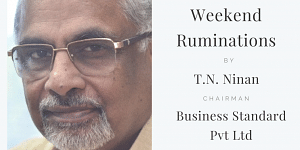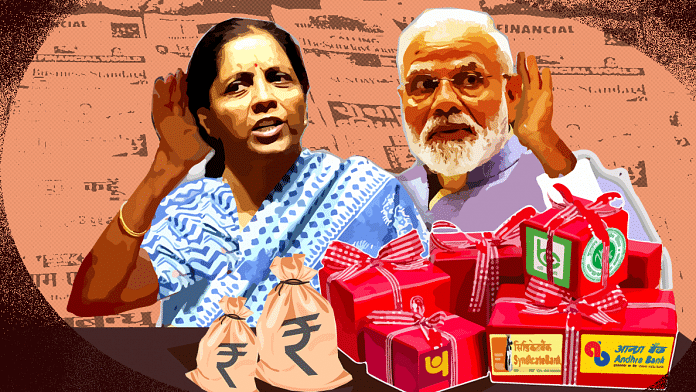It has long been said that it takes a crisis for Indian politicians to undertake systemic economic reforms. We have seen the truth of that adage over the past week. Additionally, it was probably Arun Shourie who said that, for the Modi government, managing the headlines on the economy is almost as important as managing the economy itself. That would explain the brilliant timing of the finance minister’s press conference Friday, 90 minutes before the lowest quarterly GDP growth numbers in six years were announced, with manufacturing growth at a dismal 0.6 per cent. The National Statistical Office’s ominous thunder faded in impact, given Nirmala Sitharaman’s lightning strikes in banking.
 So we have twin narratives. On the one hand, the economy’s tempo is slower than at any point since the days of the “fragile five” in 2013 (when oil prices were twice as high). Growth over the last four quarters has averaged only 6.1 per cent. With the last quarterly growth figure of just 5 per cent, and dim prospects for the current quarter, get ready for the slowest annual growth since 2012-13.
So we have twin narratives. On the one hand, the economy’s tempo is slower than at any point since the days of the “fragile five” in 2013 (when oil prices were twice as high). Growth over the last four quarters has averaged only 6.1 per cent. With the last quarterly growth figure of just 5 per cent, and dim prospects for the current quarter, get ready for the slowest annual growth since 2012-13.
The government has partially neutralised the impact of such bad news with its counter-narrative, of being responsive to the emerging situation. Since successive crises in the financial sector are seen as having impacted the broader economy by disrupting the flow of credit, the government has focused its attention on that by front-loading the re-capitalisation of its banks and now by folding 10 banks into four. Both announcements are designed to make for entities with stronger balance sheets. The RBI has chipped in with a larger-than-usual dropping of its policy rates to the lowest level in nine years.
Other announcements have come thick and fast. There have been rollbacks of tax pronouncements in the Budget, the further opening up of mining and retailing to foreign investment, and a massive subsidy for sugar exports so that mills can use the money to pay sugarcane farmers their dues. More generous depreciation rates have been designed to boost the sagging sales of commercial vehicles. Also coming, it is said, are a boost to government investment in infrastructure, incentives to promote exports, and a package for real estate. Meanwhile, the recent softening of the rupee’s external value despite weak oil prices suggests a very belated realisation that an over-valued currency does the economy no good.
It is hard to recall another week in the two Modi governments’ history that has been as packed with economic policy pronouncements. Senior government personages say that the government is now in listening mode, and willing to pay heed to criticism — something endorsed by businessmen. So what does it all amount to?
As a strategy, a steady flow of announcements is probably better than a single big-bang package that, if it fails to do the trick, leaves the situation even less hopeful than before. A continuous flow of announcements makes for lower risk and a more open-ended approach, since it can be continued till the cumulative impact makes people start thinking differently about the future, and (hopefully) begin to spend or invest more. Viewed through this prism, the government needs to do some more, and to plug some important gaps, before it can hope to change the mood.
As a first-line objective, the government would want to arrest the cyclical downswing and for consumption and investment to bottom out. Change will have to come first in consumption, since companies with stressed cash flows will hold off on investment till they see signs of improved sales. Bankers say the demand for corporate credit remains weak, but retail demand could well pick up by the festival season — if, by then, today’s postponed demand starts spilling out. However, other than addressing the problems of cane growers, the government has done little to boost rural demand. Bear in mind that agricultural prices have been depressed, and rural wages have been more or less static for the past five years. Apart from which, there remain all the structural issues that wait to be addressed. So, long haul yet before the narrative really changes.
By Special Arrangement with Business Standard
Also read: Modi govt creates bank behemoths but Q1 growth slump dampens the mood




The problem with this government is they don’t take criticism in good spirit. Yesterday in one of the TV the BJP IT cell head Amit Malviya was so arrogant in a panel which had only Subject expert. Instead of accepting the problem he was attacking Dr Singh and Mr Chitambaram to blame bad legacy. BJP in power for 5 Years plus 3 months, how long they can take shield under bad legacy. We have no strong opposition as other wise they could have launched Wake Up India at a when PM Modi is cleverly engaging with people by launching Fit India Movement.
It is painful to note that Modi is not taking advantage of the current deceleration in growth trajectory and coming out with bold policy reforms like labor law changes, agriculture land leasing, freeing of agricultural commodities from APMC and allow free exports, GST merging into single or double rate structure, combining subsidies into a DBT transfer and freeing market forces, zero income tax upto 12 lacs and let people spend etc. Modi should explain the impactof all these measures on fiscal deficit and likely inflation but get broad consensus on the reforms from general public. Many of these measures will take time but Modi must announce them with a time table for next 3 years and go after them in right earnest. Politically, Modi is in a good position as his schemes are reaching the poor efficiently and he should continue this good work. Fiscal deficit resulting from continued expenses but lowering of taxes should be managed even if there is violation of FRBM Act for next five years. He has a great opportunity to fundamentally undo legacy issues plaguing us which we all know but never had political courage to resolve. We need to free economy from bureaucratic strangling. Modi hai toh mumkin hai!
Modi hai to namumkin hai.
He has already thrown away 5 years. What will be different this time?
The BJPs all out attack on the intelligentsia and business people will come back to haunt them and India.
This is what Mao did in China in the 60s. And China lost a generation.
The government already has a huge revenue deficit. If they do all that you suggest they will have no money to invest in anything. The real issue is that the GST has proven not to be revenue neutral and it will continue to be a problem possibly for a few more years. That is also the real reason why they couldn’t lower corporate taxes to 25% for all despite promising previously. For this year the transfer from RBI can deal with the short fall but it will become a problem next year. It is unrealistic to expect a two slab GST anytime over next three years at least. On one thing you are correct and it is even possible to do, they can use this crisis to do those serious reforms in agriculture as FCI loading up on debt is unsustainable .There are no serious revenue consequences of it and it can unlock the productivity of a large part of the population. Some brave land and labor reform would be great but no politician in india can ever do that.
How long will they continue like this before the economy collapses? They’re just lurching from one crisis to another. This is not the way to run an economy as large and complex as India’s.
Easier to beat up Pakistan than to set the economy right. Ironically, Pakistan is using them same strategy: using Kashmir to cover up their problems. Both countries will finally meet, at the bottom of the pit. Then we’ll really have akhand bharat.
Sir, hats off to you for being so positive in such a negative situation . . . !
It could well be that the NDA Govt is listening to some unbiased professional advice from experts and to business views , instead of relying on half baked amateurs as earlier.
Headlines manage karne se economy manage nahin hoti. This is like the second honeymoon in an old – one would not say joyless – marriage. If farmers were promised a doubling of their incomes in five years but these have remained static, five hundred rupees will not cheer them up. 2. The receptivity to feedback, criticism, suggestions should have been there in 2014 itself. As recently as the Budget, there was a feeling of complacency. The false narrative / bravado being created by supine anchors is doing more harm than good. Results are required, not PR strategies. As Shri Arun Shourie – who would have made a better FM than his namesake – said early, We hear the clang of utensils in the kitchen but a wholesome meal is not being laid before us.
Ashok sir I must you are too good in comments. We need more people like you.
Print may kindly forward this to my admirers … Thank you, sir.